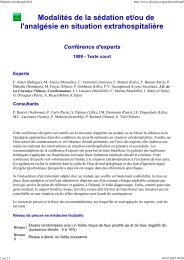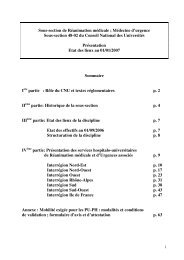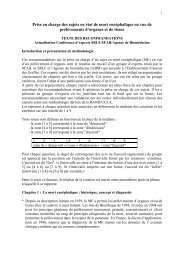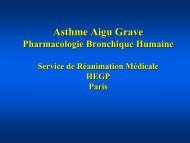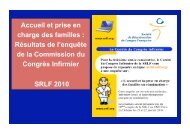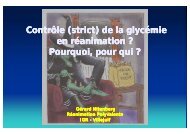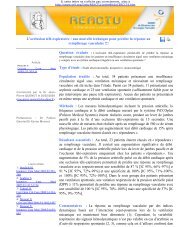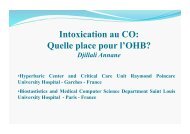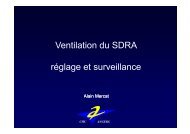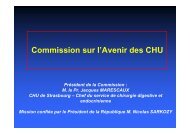Intoxications par les digitaliques - SRLF
Intoxications par les digitaliques - SRLF
Intoxications par les digitaliques - SRLF
- No tags were found...
Create successful ePaper yourself
Turn your PDF publications into a flip-book with our unique Google optimized e-Paper software.
<strong>Intoxications</strong> <strong>par</strong><strong>les</strong> <strong>digitaliques</strong>Frédéric LapostolleSAMU 93, Bobigny
Ann. For. Res. 55(1): 43-52, 2012IntroductionIn Romania, the distribution range of Norwayspruce (Picea abies) comprises about1.479.000 ha (INS 2008), which represent 77%of the area occupied by conifers and 23.4% ofthe forest cover. The Norway spruce formsalone an entire vertical vegetation belt in theCarpathian Mountains. It can also be found atlower altitudes, in mixed stands with silver firand common beech (Şofletea & Curtu 2007).IUFRO (International Union of Forest ResearchOrganizations) coordinated the establishmentof three series of experiments withNorway spruce: first in 1938/1939, the 2 nd in1964/1968 and the last one in 1972. All thepublished data afterwards in Europe show favorableresults related to Romanian provenances,both in growth traits and adaptation ability,the most valuable provenances being Margineaand Moldoviţa (Giertych 1993, Naapola1997, Alexandrov & Stancova 1997, Karlsson& Hogberg 1998, Mihai 2003, Skroppa 2005,Ujvari & Ujvari 2006).Norway spruce seed stands (populations) locatedover the entire natural distribution rangeof Norway spruce in Romania were selectedfor testing in different fields trials. Within eachpopulation, morphologically valuable treeswere selected as seed trees. The seed stands arephenotypically valuable populations of identifiedorigin, but untested from the genetic pointof view. Therefore, the purpose of the study isto identify and prove the genetic value of someof the Norway spruce seed stands in multi-sitetrials and furthermore to establish tested seedssources (Enescu & Contescu 1984), based ongenotypic selection. The results will allow creatingthe streamline for the practice decisionsregarding the aforestation works by using themost suitable forest reproductive materials dependingon environmental conditions, whichwill lead to stands that are more productiveand durable to disruptive environmental factors.As a consequence, the national and Europeanregulations regarding the production andResearch articleuse of the forest reproductive materials willalso be implemented (Pârnuţă et al. 2010).The main quantitative and adaptation traitsof the Norway spruce [Picea abies (L.) Karst.],are analyzed taking into account the data obtainedin two field trials (Avrig and Breţcu) ofthe multisite experiment established in Romaniain 1980.The most valuable populations (seed stands)resulting from the evaluations will be designatedas tested sources, and the stands where theyoriginate from will be nominated as Norwayspruce seed sources recommended to be usedin similar ecological conditions as the ones ofthe two trials.Materials and methodsThe two field trials (Avrig and Breţcu) wereestablished using seedlings resulted from theopen pollination of 10 seed trees identified ineach of the 33 seed stands (table 1).The Avrig field trial is placed outside thenatural Norway spruce area, at 615 m altitude(45 o 39 ’ 36” N, 24 o 26 ’ 12” E) and the Breţcu fieldtrial was established in the ecological optimumof the species, at an altitude between 980 and1240 m (mean altitude 1100 m, 45 o 58 ’ 16” N26 o 24 ’ 12” E).The experimental design for both field trialsis an incomplete balanced square grid design,with 3 replications and 49 seedlings per plot,planted at 2 by 2 m spacing, each populationbeing composed by descendents obtained frombulked seeds harvested from 10 trees fromeach of the seed stand tested in this experiment(Enescu & Contescu 1984).The methodology recommended byI.U.F.R.O. for the field measurements wasadopted. Thus, 10 trees were randomly measuredfrom a single plot totalizing 30 treesmeasured for each population per field trial.The data obtained were analyzed using STA-TISTICA software (Statistica 8.0). Accordingto the experimental design and the type44
Observation• 17 h 25 : Résultats…Le médecin de Md F appelle le SAMU 93 Créatinémie : 203 µmol/lKaliémie : 6,4 mmol/lDigoxinémie : 5,26 nmol/l(normale < 2,5)
Vous êtes le médecin régulateur…Femme de 91 ansAtcd : ACFA et OAPTtt : Cordarone®, Digoxine®, Aldalix®Troub<strong>les</strong> digestifs et troub<strong>les</strong> visuelsQuelle décision ?Créatinémie : 203 µmol/lKaliémie : 6,4 mmol/lDigoxinémie : 5,26 nmol/l(normale < 2,5 nmol/l)
Observation17 h 45 : Arrivée du SMURPatiente en bon état général, nauséeusePA : 180/85, FC : 48/minuteExamen clinique sans <strong>par</strong>ticularité
Simone, 91 ans, surdosée en digitaliqueGravité ? Pronostic ?
Gravité et pronosticRisque vital immédiatTachycardie ou fibrillation ventriculairesBradycardie < 40/min (réfractaire atropine)Kaliémie > 5 meq/LInfarctus mésentériqueChoc cardiogéniqueRisque vital potentiel : facteurs de risque / de gravitéAge > 55 ansSexe masculinCardiopathie préexistanteBloc auriculo-ventriculaireKaliémie > 4,5 meq/LBradycardie < 60/min (réfractaire atropine)
Lapostolle, Intens Care Med, 2008Aiguës (%) Chroniques (%) pSexe masculin 29,3 34,2 NSAge > 55 ans 50,9 96,5 < 0,0001ATCD cardiologiques 54,3 98,6 < 0,0001FC < 60 bat.min -1 41,4 17,4 < 0,0001FC < 40 bat.min -1 2,6 3,2 NSBAV1 17,2 11,6 NSBAV2 ou BAV3 14,7 11,2 NSTous BAV 31,9 22,9 < 0,05TV, FV, ou ESV 11,2 13,4 NSTV ou FV 4,4 1,4 < 0,05PAS < 100 mmHg 8,6 7,2 NSK > 5 mmol.l -1 21,6 23,3 NSK > 4,5 mmol.l -1 42,2 51,1 NS
Simone, 91 ans, surdosée en digitaliqueQuelle stratégie thérapeutique ?
Stratégies thérapeutiques• 68 patients traités <strong>par</strong> EESI• 34 patients traités <strong>par</strong> anticorps• 150 patients traités <strong>par</strong> anticorpsBismuth, Clin Toxicol, 1977Smolarz, Clin Toxicol, 1985Antmann (Smith), Circulation, 1990
Stratégie thérapeutique d’é<strong>par</strong>gneRisque vital immédiatTachycardie ou fibrillation ventriculairesBradycardie < 40/min (réfractaire atropine)Kaliémie > 5 meq/LInfarctus mésentériqueChoc cardiogéniqueNeutralisationcurative(équimolaire)Risque vital potentiel : facteurs de risque / de gravitéAge > 55 ansSexe masculinCardiopathie préexistanteBloc auriculo-ventriculaireKaliémie > 4,5 meq/LBradycardie < 60/min (réfractaire atropine)
EESI vs anticorps : 1 seule étudeEESI EESI + Fab FabPatients 23 16 12Mortalité 17 % 31 % 25 %Taboulet, J Toxicol Clin Toxicol, 1993
Stratégie d’é<strong>par</strong>gne ?Evaluent (tous) un traitement curatifConfirment efficacité et toléranceMortalité résiduelle : 25 % environ…Patients meurent guéris…Maniement Fab plus aisé que EESITaboulet, J Toxicol Clin Toxicol, 1993
Stratégie thérapeutiqueIntroduction de l’idéed’un traitement prophylactiqueSmolarz, Clin Toxicol, 1985Woolf, Am J Emerg Med, 1991Taboulet, J Toxicol Clin Toxicol, 1993
Stratégie thérapeutique prophylactique d’é<strong>par</strong>gneRisque vital immédiatTachycardie ou fibrillation ventriculairesBradycardie < 40/min (réfractaire atropine)Kaliémie > 5 meq/LInfarctus mésentériqueChoc cardiogéniqueRisque vital potentielAge > 55 ansSexe masculinCardiopathie préexistanteBloc auriculo-ventriculaireKaliémie > 4,5 meq/LBradycardie < 60/min (réfractaire atropine)Neutralisationcurative(équimolaire)Neutralisationprophylactique(semi-équimolaire)
Stratégie prophylactiqueRisque vital immédiatTachycardie ou fibrillation ventriculairesBradycardie < 40/min (réfractaire atropine)Kaliémie > 5 meq/LInfarctus mésentériqueChoc cardiogéniqueRisque vital potentielAge > 55 ansSexe masculinCardiopathie préexistanteBloc auriculo-ventriculaireKaliémie > 4,5 meq/LBradycardie < 60/min (réfractaire atropine)Stratégie privilégiée 1990-2004Neutralisationcurative(équimolaire)Neutralisationprophylactique(semi-équimolaire)
Stratégie prophylactique• Mortalité faible7,5 % sur 66 patients traités <strong>par</strong> Fab• Sans inflation de coûtni en nombre de flacons (4,3)ni en durée de séjour (4,3)Lapostolle, Crit Care Med, 2008
Simone, 91 ans, surdosée en digitaliqueQuel<strong>les</strong> limites à ce traitement ?
Bruner G, Lancet, 2000
Fréquence des intoxicationsEtude rétrospective sur 2 ans, 22 centresMoyenne : 42 patients <strong>par</strong> centreNantes : 208 Brest : 160Gonesse : 101 Versail<strong>les</strong> : 66Toulon : 73 Aulnay : 57Montfermeil : 48 Bobigny : 36Lapostolle, Intens Care Med, 2008
Utilisation des anticorps<strong>Intoxications</strong> aiguës vs chroniques<strong>Intoxications</strong>Aiguësn = 116Chroniquesn = 722pAtropine (%) 31,9 4,8 < 0,0001Anticorps (%) 41,4 2,5 < 0,0001EESI (%) 2,6 1,2 NSLapostolle, Intens Care Med, 2008
Utilisation des anticorps<strong>Intoxications</strong> aiguës vs chroniques<strong>Intoxications</strong>Aiguësn = 116Chroniquesn = 722Atropine (%) 31,9 4,8 < 0,0001Anticorps (%) 41,4 2,5 < 0,0001EESI (%) 2,6 1,2 NSMortalité (%) 5,2 15,8 < 0,005Lapostolle, Intens Care Med, 2008p
Quels patients sont traités « dans la vraie vie »OR IC 95% pIntoxication volontaire 20,3 8,9-46,5 < 0,0001Anticorps dans l’hôpital 7,9 2,6-23,8 0,0003,FC 1,05 1,02-1,06 0,0001Lapostolle, Rev SAMU, 2010
<strong>Intoxications</strong> <strong>digitaliques</strong>Place du traitement <strong>par</strong> FabFred LapostolleSAMU 93
Rendre accessib<strong>les</strong> <strong>les</strong> FabMieux connaître l’intoxication &Les indications des anticorpsSavoir où trouver <strong>les</strong> FabCompétence + Stockage + AcheminementSAMU 93 Rôle du SAMU
Lapostolle, Presse Med, 2001Ruscev, Urgences 2009
Revenons (encore) à Md F…Bradycardie, trouble de la conduction (BSA III), cupule digitalique…
Pronostic et choix thérapeutiqueChoixdutraitementCuratif si risque vital immédiatTrouble du rythme ventriculaire (TV / VF)Bradycardie < 40/min (après atropine)Kaliémie > 5 mmol/lChoc cardiogèniqueProphylactique si mauvais pronosticSexe masculinAge > 55 ansCardiopathie préexistanteBAV II / IIIBradycardie < 60/min (après atropine)Kaliémie > 4,5 mmol/l
Evolution • 18 h 30 : traitement <strong>par</strong> Fab débuté sur placeDose prophylactique (Digidot®, 1 flacon en 2 h). Patiente transférée enréanimation toxicologique• 20 h : dis<strong>par</strong>ition des signes d'intoxication (digestifs, électrocardiographiqueset biologiques)• J 4 : retour à domicile après évolution simple (normalisation de lafonction rénale)
Expérience du SAMU 93SAMU 93 8 patientes âgées, traités <strong>par</strong> Fab, lors d’interventions primaires (4 cas) et à lademande de services d’urgence ou de cardiologie (4 cas).Sexe Femme Femme Femme Femme Femme Femme Femme FemmeAge 91 ans 96 ans 84 ans 80 ans 90 ans 90 ans 84 ans 80 ansContexte Surdosage Surdosage Surdosage Surdosage Surdosage Surdosage Surdosage SurdosageAtcd cardio oui oui oui oui oui oui oui ouiLieu Domicile Domicile SAU USIC SAU Domicile USIC DomicileFC (batt/min) 54 45 40 40 54 30 30 40ECG ACFA BAV 3 BSA 3 ACFA BAV 2 BSA 3 ACFA ACFAK (mmol/l) 6,1 - 9,6 6,0 4,2 5,9 5,1 -Traitement Prophylaxie Prophylaxie Prophylaxie EESI+curatif Prophylaxie Prophylaxie Prophylaxie ProphylaxieDose Digidot® 1 flacon 1 flacon 1 flacon 2 flacons 1 flacon 1 flacon 2 flacons 2 flaconsEvolution Vivante Vivante Vivante Décédée Vivante Vivante Vivante VivanteLapostolle, Urgences 2006
Pour conclure…
ConclusionMédicament et toxique ancienToxicité fréquenteMais im<strong>par</strong>faitement connueTraitement salvateur (Fab) mais sous utiliséStratégies thérapeutiques (prophylactique !)à organiser
Merci...




